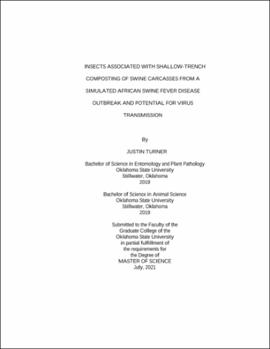| dc.description.abstract | African Swine Fever (ASF) Virus is a double-stranded DNA virus that causes a highly contagious hemorrhagic disease with almost 100% mortality in swine. Soft ticks (Argasidae), swine lice (Haematopinus suis), and stable flies (Stomoxys calcitrans) are competent insect vectors of the virus. These studies focused on insects associated with the burial site of pig carcasses and the potential of identified insects to transmit ASF from burial sites. For the first study, shallow-trench composting of pig carcasses was examined, with 50 pigs each buried under soil in two trenches, 50m long x 0.6m deep x 2m wide, lined with 0.3m of wood chips. Both femurs were inoculated, at time of burial, with swine pox virus to model ASFV infection. Pitfall and malaise traps were used to collect attracted insects. Traps were sampled every 2-3 days August-October, once-a-month November-March, and every other week from April-September. All insects were identified to family with further classification of Coleoptera and Diptera specimens to genus or species. A total of 22,730 arthropods were identified. The most common fly family was Calliphoridae and the beetle family Silphidae was found only at the trench site. To assess persistence of swine pox virus and its movement by insects, insects within the animal mortality trenches were collected post-burial after 1, 2, and 3 weeks, and at 1,2,4,6 and 12 months. The second study examined house flies vector competence for three surrogate viruses: Swinepox (SwPV), Bovine Viral Diarrhea Virus (BVDV), and Senecavirus A (SVA). Twenty-four flies were exposed to one virus for 1 hour and at 0, 6, 12, 24, and 48 hours post exposure the flies were collected. Then flies were tested for presence of DNA/RNA and viable virus. All flies exposed to SVA, males at hour 0 for BVDV, and SwPV females at hour 6 had viable virus. Proven vectors of ASFV were found at the animal mortality trenches with an expected emergence date two days after the last time viable virus was collected from the trenches. House flies were shown to be able to hold viable SwPV, surrogate for ASFV, for 6 hours post exposure. | |
